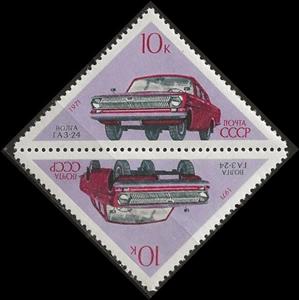Tete-Beche: Car - Volga GAZ-24 (Soviet Union, USSR 1971)
Car - Volga GAZ-24 (Soviet Union, USSR 1971)
12 May (Soviet Union, USSR ) within release Soviet Motor Industry goes into circulation Tete-Beche Car - Volga GAZ-24 face value 2*10 Russian kopek
| Tete-Beche Car - Volga GAZ-24 in catalogues | |
|---|---|
| Michel: | Mi: SU 3882K |
Tete-Beche is square format.
Issued in sheets of 20 (5 x 4) tete-beche pairs. Exists on both ordinary and UV reactive paper.Also in the issue Soviet Motor Industry:
- Stamp - Soviet Motor Industry - Volga GAZ-24 face value 10;
- Tete-Beche - Car - Moskvich-412 face value 2*4;
- Tete-Beche - Car - Volga GAZ-24 face value 2*10;
- Tete-Beche - Car - Zaporozhets ZAZ-968 face value 2*4;
- Tete-Beche - Truck - BelAZ-540 face value 2*3;
- Tete-Beche - Truck - GAZ-66 face value 2*2;
Tete-Beche Car - Volga GAZ-24 it reflects the thematic directions:
The automotive industry comprises a wide range of companies and organizations involved in the design, development, manufacturing, marketing, selling, repairing, and modification of motor vehicles. It is one of the world's largest industries by revenue (from 16% such as in France up to 40% in countries such as Slovakia).
A car is a wheeled, self-powered motor vehicle used for transportation and a product of the automotive industry. Most definitions of the term specify that cars are designed to run primarily on roads, to have seating for one to eight people, to typically have four wheels with tyres, and to be constructed principally for the transport of people rather than goods. The year 1886 is regarded as the birth year of the modern car. In that year, German inventor Karl Benz built the Benz Patent-Motorwagen. Cars did not become widely available until the early 20th century. One of the first cars that was accessible to the masses was the 1908 Model T, an American car manufactured by the Ford Motor Company. Cars were rapidly adopted in the United States of America, where they replaced animal-drawn carriages and carts, but took much longer to be accepted in Western Europe and other parts of the world.
The Kionga Triangle (German: Kionga-Dreieck, Portuguese: Triângulo de Quionga) was a small region of German East Africa situated at the mouth of the Ruvuma River. The Ruvuma served as the border between the German colony and Portuguese Mozambique, and the Kionga Triangle was the only section of German East Africa south of the river. Its principal settlement was Kionga (now Quionga ) which had a population of 4,000 in 1910. It became a German possession in 1894 but came under Portuguese control in April 1916 during World War I. The post-war Treaty of Versailles reaffirmed that the river was the border between Tanganyika, then under British control, and Portuguese Mozambique. The triangle was the only territory that the treaty awarded to Portugal.
A vehicle (from Latin: vehiculum) is a mobile machine that transports people or cargo. Typical vehicles include wagons, bicycles, motor vehicles (motorcycles, trucks, buses), railed vehicles (trains, trams), watercraft (ships, boats), aircraft and spacecraft. Land vehicles are classified broadly by what is used to apply steering and drive forces against the ground: wheeled, tracked, railed or skied. ISO 3833-1977 is the standard, also internationally used in legislation, for road vehicles types, terms and definitions.



